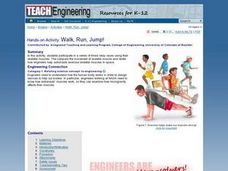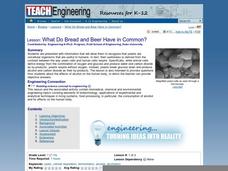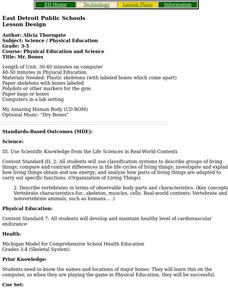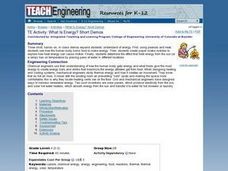Curated OER
Brain Watching
Students identify the different parts of the nervous system. In this biology lesson, students research methods to diagnose and cure neurological disorders. They present their report to class.
Curated OER
Golden Ratio of the Human Body
Young scholars calculate the ratio of the height of the body to the height of the navel. They discover that the ratios are all approximately equal.
Curated OER
Mrs. Moore's Question
Fifth graders answer a fictitious question asked by their school principal. After reading the question together, they write an appropriate response and show her what they have gathered about the circulatory system. They type their letter...
Curated OER
Where Will I Go?
In this digestive system worksheet, 3rd graders use a word bank given to label parts of the digestive system. An answer key and website reference for additional resources are given.
Curated OER
Walk, Run, Jump!
Students participate in a series of timed relay races using their skeletal muscles. They compare the movement of skeletal muscle and relate how engineers help astronauts exercise skeletal muscles in space. They list the three types of...
Curated OER
How To Make an Artificial Organ
High schoolers examine the advances made in technology with regard to prosthetics and replacement organs and limbs. They describe the anatomy and functions of different organs and create their own artificial organ. They defend and...
Curated OER
Urinalysis
In this health worksheet, young scholars examine the human body and make mental connections to the target function highlighted in the sheet.
Curated OER
Bone Density
Students recognize how the strength and density of bone can reduce fractures. In this bone density lesson, students calculate density as they measure volume and mass of serial bone specimens in a group activity.
Curated OER
Art and Anatomy: The Vitruvian Teen
Students are introduced to the history of showing the human anatomy. In groups, they measure their height and arm spans to create a graph and determine if their measurements support Vitruvius' work. Individually, they make their own...
Curated OER
Ya' Gotta Have Heart
Fourth graders study the parts of the human circulatory system and how they function. They design a flow chart of the circulatory system and use data to construct charts and graphs.
Curated OER
Nutrition 2: Good Food, Good Health
Students explore ways in which food provides energy and materials for our bodies.
Curated OER
Artificial Heart Technology
Students discover the basics of the human heart and how it functions. They examine the whole circulatory system and how an electric heart would work inside the human body. They can choose to perform their own surgery by following...
Curated OER
Medical Instrumentation
Students analyze how medical devices that help the human body function. They work in pairs or groups to draw multiple views of the medical device and describe how engineering is used by biomedial engineers.
Curated OER
As Good As Gold
Students find examples of the Golden Ratio on the human body through measurement. Additionally, students learn about the use of the Golden Ratio and the Golden Rectangle in art and architecture. A very interesting lesson for the students!
Curated OER
What Do Bread and Beer Have in Common?
Students listen to an explanation of yeast cells and how they effect bread and beer. They discuss the ways alcohol affects the human body and participate in an indirect observation about cell respiration in yeast-molasses cultures.
Curated OER
Beef (Advanced)
In this beef worksheet, students participate in a variety of activities including completing a digestion dilemma, identifying best meat cuts and selecting a service project to complete.
Curated OER
Mr. Bones
Students play CD-ROM game My Amazing Human Body, and participate in relay game in Phys. Ed. where they put together skeleton on which body parts are labeled.
Curated OER
What Is Energy? Short Demos
Students engage in three short, hands-on, in-class demos which expand students' understand of energy. First, using peanuts and heat, students see how the human body burns food to make energy. Then, they create paper snake mobiles to...
Curated OER
Broken Bones
Students examine a variety of injuries that can happen to the human body and discover the process of maintaining healthy bones. After discussing the process of bone repair following a break, they draw the process in cartoon style and...
Curated OER
Tissues
In this tissue worksheet, students are given notes on 6 types of epithelial tissues, 10 examples of connective tissue, three types of muscular tissue and the components of nerve tissue.
Curated OER
Substance Abuse
Students describe the effects of drugs on the human body, both short-and long-term consequences. They create personal approaches to substance abuse control and prevention. Students demonstrate effective practices in working within...
Curated OER
The Beat Goes On
Students take their own pulse before and after exercise as they explore how the heart works. They research various ways that heart disease is treated and suggest specific treatment methods for their own imaginary patients.
Curated OER
21st Century Medicine: Nerves of Steel
Young scholars model a sarcomere's action, they gain a kinesthetic and visual understanding of muscle contraction. They use this exercise stimulates the production of myosin and actin. Students use two colors of clay, make a "sandwich"...
Curated OER
How to Make an Artificial Organ
Students design bionic organs or limbs. In this medical technology lesson, students view a video about artificial organs and prosthetic limbs. They research the medical technology behind these advances and work to design a organ or limb...
Other popular searches
- Human Body Anatomy
- Human Body Anatomy Sketching
- Human Body Anatomy Diagrams
- Human Biology and Anatomy
- Human Body Anatomy Muscles
- Human Body Anatomy Game
- Human Brain Anatomy
- Human Body Anatomy Brain
- Human Body Anatomy Bones
- Human Heart Anatomy
- Human Body Anatomy Hearing
- Human Body Anatomy Veins























